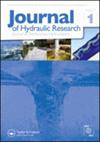Application of CFD to predict the sluice gate jammed
IF 1.7
3区 工程技术
Q3 ENGINEERING, CIVIL
引用次数: 0
Abstract
AbstractThe problem of sluice gate jamming in moving water occurs frequently in engineering practice. In this study, the reason for gate jamming is investigated by using computational fluid dynamics and verified by model tests with variable friction coefficients. The results show that the gate geometry is reasonable and the downpull force of the sluice gate can be fully utilized. Due to being submerged in water for many years, high friction coefficient is the main reason for the non-closure of a sluice gate. The permissible friction coefficient is related to the submerged weight, available areas of panel and beam, and water level difference. Decreasing the guide vane opening and lowering the water level difference to decrease the average pressure head are feasible ways to promote the gate closure in an emergency. Adding a convex bottom edge and dividing the whole gate into two sections to increase the permissible friction coefficient are effective ways to achieve complete closure in the modification stage.Keywords: CFDfriction coefficientgate closuremodel testsluice gate jammed Disclosure statementNo potential conflict of interest was reported by the author(s).NotationA=guide vane opening ratio (–)A1=available area of the panel (m2)A2=available area of the beam (m2)A2’=available area of the beam with a convex edge (m2)e=gate opening (m)e0=tunnel height (m)E=gate opening ratio (–)Fb=downpull force (kN)Fp=pulling force (kN)Fn=horizontal force (kN)Gg=submerged weight force (kN)h=average pressure head (m)hb=average pressure head on beam (m)hp=average pressure head on panel (m)H=pressure head ratio (–)ΔH=water level difference between the upstream and downstream (m)ΔH0=original water level difference (m)ΔHr=water level ratio (–)l=length of the convex edge (m)Lr=convex edge length ratio (–)P=fluid pressure (Pa)Pback=pressure of back surface (Pa)Pfron=pressure of front surface (Pa)Plower=pressure of lower surface (Pa)Pupper=pressure of upper surface (Pa)Sr=height ratio (–)Ss=height of the water seal (m)Su=height of the upper gate (m)t=time (s)Tb=width of the beam (m)ui, uj=horizontal and vertical velocity components (m s−1)ui’, uj’=horizontal and vertical velocity fluctuation component (m s−1)v=flow velocity (m s−1)vmax=the maximum flow velocity (m s−1)Wb=span of the beam (m)Ws=span of the water seal (m)η=turbulent (eddy) viscosity (Pa s)µ=friction coefficient (–)µp=permissible friction coefficient (–)τij’=turbulent stresses (Pa)υ=dynamic viscosity coefficient (Pa s)Additional informationFundingThis work was supported by the National Key Research and Development Program of China [grant 2018YFC15084], National Natural Science Foundation of China, the Foundation for Innovative Research Groups of the Natural Science Foundation of Heibei Province China, the Foundation for Innovative Research Groups of the Natural Science Foundation of Heibei Province [grant U20A20316 and E2020402074], and Science and Technology Development Projects of Wuqing [grant WQKJ202033].应用CFD预测水闸卡壳
摘要在工程实践中,闸门在动水中卡闸的问题经常发生。本文采用计算流体力学的方法分析了闸门堵塞的原因,并通过变摩擦系数模型试验进行了验证。结果表明,闸门几何形状合理,能充分利用闸门的下拉力。由于水闸在水中浸没多年,高摩擦系数是水闸不合闸的主要原因。允许摩擦系数与沉水重量、板梁可用面积和水位差有关。减小导叶开度和降低水位差降低平均压头是紧急情况下促进闸门关闭的可行方法。在改型阶段,增加凸底边和将整个浇口分成两段增加允许摩擦系数是实现完全闭合的有效途径。关键词:cfd摩擦系数闸门关闭模型试验闸门堵塞披露声明作者未报告潜在的利益冲突。注:a =导叶开度比(-)A1=面板有效面积(m2)A2=梁有效面积(m2)A2 ' =凸边梁有效面积(m2)e=闸门开度(m)e0=隧道高度(m)e =闸门开度比(-)Fb=下拉力(kN)Fp=拉力(kN)Fn=水平力(kN)Gg=沉重力(kN)h=平均压头(m)hb=梁平均压头(m)hp=面板平均压头(m)h =压头比(-)ΔH=上游水位差下游(m)ΔH0=原水位差(m)ΔHr=水位比(-)l=凸边长度(m)Lr=凸边长度比(-)P=流体压力(Pa)Pback=后表面压力(Pa)Pfron=前表面压力(Pa)Plower=下表面压力(Pa)Pupper=上表面压力(Pa)Sr=高度比(-)Ss=水封高度(m)Su=上闸门高度(m)t=时间(s)Tb=横梁宽度(m)ui, uj=水平和垂直速度组成(m s - 1)ui ',uj′=水平和垂直速度波动量(m s−1)v=流速(m s−1)vmax=最大流速(m s−1)Wb=梁跨(m)Ws=水封跨(m)η=湍流(涡流)粘度(Pa s)µ=摩擦系数(-)µp=允许摩擦系数(-)τij′=湍流应力(Pa)υ=动力粘度系数(Pa s)附加信息基金资助:国家重点研发计划[grant 2018YFC15084],国家自然科学基金项目、河北省自然科学基金创新课题组项目、河北省自然科学基金创新课题组项目[grant U20A20316和E2020402074]、武清市科技发展计划项目[grant WQKJ202033]。
本文章由计算机程序翻译,如有差异,请以英文原文为准。
求助全文
约1分钟内获得全文
求助全文
来源期刊

Journal of Hydraulic Research
工程技术-工程:土木
CiteScore
4.90
自引率
4.30%
发文量
55
审稿时长
6.6 months
期刊介绍:
The Journal of Hydraulic Research (JHR) is the flagship journal of the International Association for Hydro-Environment Engineering and Research (IAHR). It publishes research papers in theoretical, experimental and computational hydraulics and fluid mechanics, particularly relating to rivers, lakes, estuaries, coasts, constructed waterways, and some internal flows such as pipe flows. To reflect current tendencies in water research, outcomes of interdisciplinary hydro-environment studies with a strong fluid mechanical component are especially invited. Although the preference is given to the fundamental issues, the papers focusing on important unconventional or emerging applications of broad interest are also welcome.
 求助内容:
求助内容: 应助结果提醒方式:
应助结果提醒方式:


